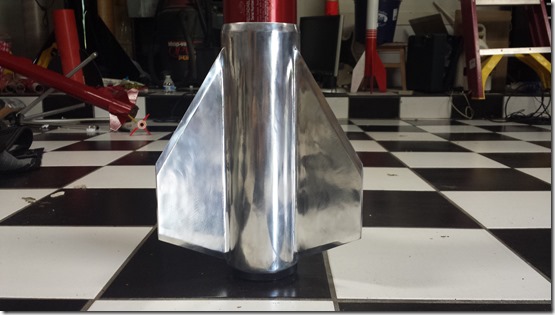I have one of these 98mm minimum diameter aluminum fincan from Rebel Space as well for my Cesaroni 98mm 6XL motor after Frank showed me the prototype. I’m thinking of flying it as a minimum diameter rocket on a O3400. I completely agree with you for your description of the quality and finishing as mine looks exactly the same. My fincan weights 1920grams. It is very sturdy and I think this is the way forward with all 98mm minimum diameter flights. Why gamble a $2.000,- motor & reload on a carbon fiber lay up if you can get an aluminum fin can. The reason I got one of these fincans is that I saw many minimum rockets fails with a composite lay up. I don’t get around launching many of these rockets because you can’t launch them in Europa and the costs of a motor & reload so I better make it the first time right.
I took some measurements and was deeply impressed of the workmanship – not only because it is shiny; that’s the easy part. ID is 99,00mm exactly on my digital caliper – ID must have been machined after welding. No distortion at all. It slides really easy over the Cesaroni 98mm 6XL casing (OD 98,55mm) with very little play. I think I’ll just JB weld it to the casing. The fin can also has some sort of shoulder on which a body tube could be supported. I’m not sure how to describe this better but I took a picture of it with a piece of phenolic tube. I think I will not use that feature and use some JB Weld to make it flush with the casing.
The first thing I thought of when looking at the fins they could be used for the Gillette commercial with the razor blade animation. They are that sharp, I also tried to take a picture from it with my phone but it does not do justice to how sharp and true these leading edges are. Fin shape and size / look-n-feel a bit like a combination of Mongoose 98mm fins and the “Don’t Debate This” rocket from Mike Passeratti.
I took a part of another rocket just to have a feel how this rocket would look like and added some piuctures. Don't mind the greasy fingerstains on the fincan. I'm not sure yet whether to paint this fincan my usual fluorescent orange color or leave it shiny like this. Some time ago I tracked an all-aluminum rocket all the way up to apogee because it was glinting and really stood out against a clear blue sky.
Anybody else got one of these flying at BALLS this year? I like mine a lot and maybe see you at BALLS 2014.











